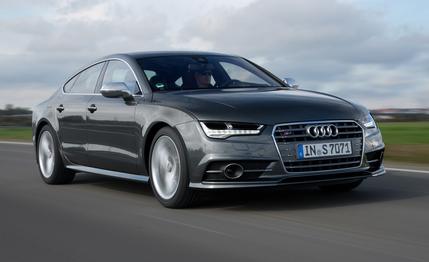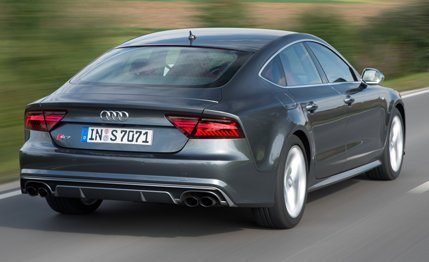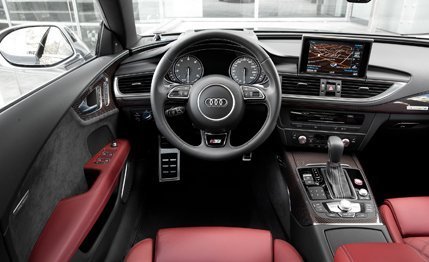 First Drive Review
First Drive Review
Audi’s lineup of hatchbacked sedans is being refreshed for 2016. Having already driven the updated A7 and RS7, it’s time for us to focus on the model those cars bracket: the S7. It receives cosmetic and mechanical updates that seem minor but go a long way toward making a great car even better.
On the outside, the current model’s boxy front fascia with its near-rectangular lower air intakes has been replaced by a treatment that’s just as sporty but more elegant. The new LED head- and taillamps of the A7 and RS7 are here, too, while the S-trademark quadruple exhaust pipes remain.
Under the hood, the S7’s twin-turbocharged 4.0-liter V-8 has gone to the gym, muscling up from 420 horsepower to a nice, fat 450. Torque is unchanged, but 406 lb-ft should do the trick for just about anyone. If the engine sounds familiar, that’s because it spreads far and wide across the Audi lineup (as well as Bentley), finding a home in the engine bay of the S6 and RS7, among other models. But it has a different, less rowdy character here than in the RS car. The power is delivered forcefully, sure, but without the raucous bellow and rawness of the RS7. Its smooth and seamless character belies how quick this car is once you cane the thing, and the S7 charges easily up to a governed 155-mph top speed.

The shifts from the seven-speed dual-clutch automatic are crisp and ultraquick. It’s the only member of the A7 family that has this transmission, in fact, as the lesser cars utilize an eight-speed torque-converter automatic—a nod to buyers’ preference for smooth launches versus quick shifts. The RS7 even has the same eight-speed ’box, as the dual-clutch unit can't deal with its additional 110 lb-ft of twist.
Based on the modular-longitudinal MLB platform, the S7 has light and precise steering, and the car as a whole feels much smaller than it is while cornering, thanks in large part to the near-telepathic sports differential. That piece aims to sharpen turn-in and mitigate the understeer inherent in a front-drive-based platform—the S7 has Quattro all-wheel drive as standard—by routing torque back and forth between the rear wheels as needed to maintain a chosen driving line.

The interior is one of the nicest in its class, and it has received the same upgrades as the 2016 A7 and RS7. The instrument panel in front of the driver can now be specified as a big ol’ TFT display placed between the tachometer and speedometer, and the MMI infotainment and telematics system has been updated to the latest version. Other notable items include fancy new wood trim and a cozier working relationship between the various driver-assistance systems. Our test car was fitted with a curious carbon-fiber trim that incorporated red weave, a look that was as sporty as it was an acquired taste. We’re not sure if that option will make it to the U.S., and we’re not sure it matters.
Although Audi doesn’t use the "four-door coupe" nomenclature favored by some competitors, the S7 nevertheless butts heads with the BMW 650i xDrive Gran Coupe and the Mercedes-Benz CLS550. It separates itself from those cars with its large, wide-opening hatch, which imparts a heavy dose of practicality into what is ultimately an executive express. It’s also a bit sportier to drive than those cars.
Yet even though it shares the same basic engine with the RS7, the S7 is closer in character to the regular A7. The car is fleet of foot, yes, but it doesn't pretend like it got lost on the way to the racetrack. It also won’t wake up your neighbor in the morning when you fire it up. Quite simply, the S7 emphatically underscores the elegance of the A7 with an even more compelling driving experience.